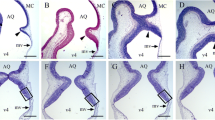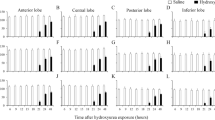Abstract
This report deals with the mechanism involved in the cerebellar degeneration following experimental methylmercury poisoning of male Wistar rats. The cerebellar granule cells of animals that exhibited typical hind leg paresis were shrunken and displayed marked nuclear pyknosis. At the ultrastructural level, the nuclei of these cells were condensed and fragmented, features which are characteristic of apoptosis. In situ staining for DNA strand breaks revealed that the pyknotic nuclei were positively labeled. DNA fragmentation was confirmed by agarose gel electrophoresis; a ladder pattern of multiples of approximately 200-base pair fragments, typical of apoptosis, was observed with the cerebellar DNA of the methylmercury-treated animals. These observations suggest that the degeneration of cerebellar granule cells by alkyl mercury compounds involves an apoptotic process.
Similar content being viewed by others
Author information
Authors and Affiliations
Additional information
Received: 21 June 1995 / Revised, accepted: 11 September 1995
Rights and permissions
About this article
Cite this article
Nagashima, K., Fujii, Y., Tsukamoto, T. et al. Apoptotic process of cerebellar degeneration in experimental methylmercury intoxication of rats. Acta Neuropathol 91, 72–77 (1995). https://doi.org/10.1007/s004010050394
Issue Date:
DOI: https://doi.org/10.1007/s004010050394




